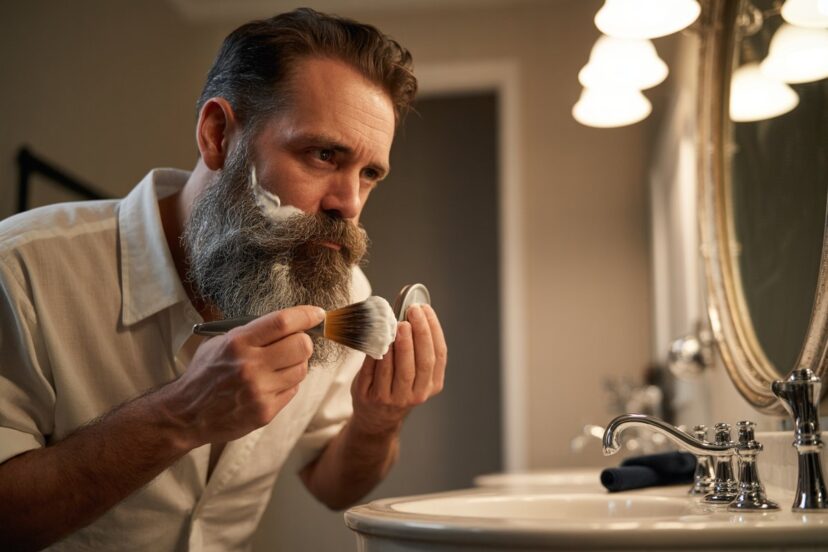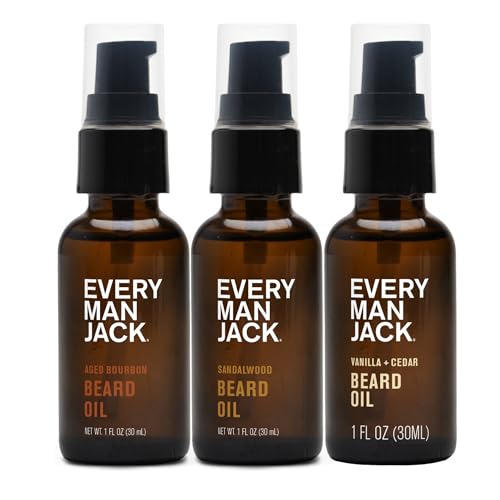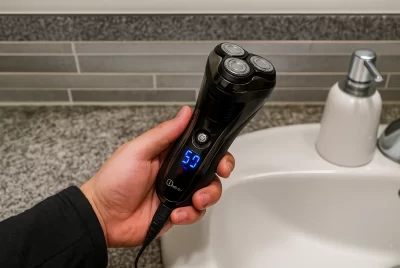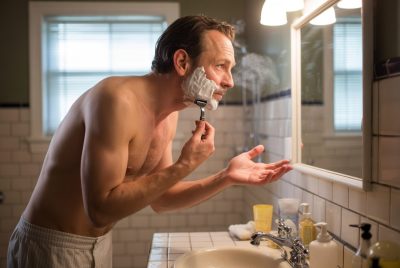How to Soften a Coarse Beard Before Shaving
Post Disclaimer
*We may earn a commission for purchases made using our links. Please see our disclosure to learn more.
The mirror doesn’t lie. That reflection staring back shows a beard that feels more like steel wool than soft facial hair. The frustration builds as another razor drags across stubborn whiskers, pulling and tugging with each stroke. The irritation follows—red bumps, ingrown hairs, and that uncomfortable burning sensation that lingers long after the shave is done.
This struggle is familiar to countless men dealing with coarse, wiry beards. The difference between a painful shaving experience and a smooth, comfortable one often comes down to proper preparation. Understanding how to soften a coarse beard before shaving transforms not just the shaving routine, but also skin health and overall grooming confidence.
“A well-prepared beard is the foundation of a perfect shave. The difference between comfort and irritation often lies in those few minutes of proper preparation.”
— Master Barbers’ Guild
Key Takeaways
- Hydration is fundamental: Water penetration weakens hair structure, making coarse beards up to 70% easier to cut
- Pre-shave oils create protective barriers: They reduce friction and provide essential moisture to stubborn facial hair
- Heat opens follicles: Warm water and steam make beard hair more pliable and receptive to softening treatments
- Quality products matter: The right combination of beard wash, conditioner, and softening oils makes a measurable difference
- Patience pays off: Taking 3-5 minutes for proper beard preparation prevents hours of post-shave irritation
Recommended Products for Beard Softening
Before diving into techniques, here are four highly-rated products available on Amazon that address coarse beard challenges:
Polished Gentleman Beard Wash and Conditioner Set
Looking for the best way to soften a coarse beard before shaving? The Polished Gentleman Beard Wash and Conditioner Set is designed to transform even the roughest facial hair into smooth, manageable strands. Infused with biotin, tea tree, manuka honey, rosemary, and aloe vera, this powerful duo not only cleanses your beard but deeply conditions it—making each shave gentler, smoother, and irritation-free.
When it comes to softening a coarse beard before shaving, the Polished Gentleman Beard Wash and Conditioner Set stands out as a grooming essential. Coarse facial hair can be tough, wiry, and resistant to razors—but this dual-action formula changes the game.
- Deep Softening: Effectively softens coarse beard hair before shaving, making each stroke smoother and reducing tugging.
- Natural Ingredients: Infused with biotin, aloe vera, and tea tree for hydration and nourishment without harsh chemicals.
- Beard Growth Boost: Promotes thicker, fuller beard growth while keeping hair manageable and itch-free.
- Small Size: The 4 oz bottles may not last long for daily users with longer beards.
- Mild Scent: Unscented formula may feel too plain for users who prefer a fragrant beard wash.
- Premium Price: Slightly higher cost compared to basic beard shampoos, though justified by quality ingredients.
Every Man Jack Beard Oil Variety Pack
If you’re looking to soften a coarse beard before shaving, the Every Man Jack Beard Oil Variety Pack delivers a natural, premium grooming experience. This 3-pack includes Sandalwood, Vanilla + Cedar, and Aged Bourbon beard oils — each formulated with shea butter and naturally derived ingredients that deeply moisturize facial hair and the skin beneath.
Preparing to shave a coarse beard doesn’t have to be a struggle. The Every Man Jack Beard Oil Variety Pack is a simple, effective way to soften coarse beard hair before shaving while nourishing your skin. With three rich scents—Sandalwood, Vanilla + Cedar, and Aged Bourbon—this grooming essential offers both performance and variety.
- Deep Moisture: Effectively softens coarse beard hair before shaving, reducing tugging and irritation.
- Natural Formula: Made with shea butter and plant-based oils — phthalate-free and gentle on skin.
- Variety of Scents: Includes Sandalwood, Vanilla + Cedar, and Aged Bourbon for refreshing daily grooming.
- Small Bottles: Each 1 oz bottle may run out quickly with daily use.
- Scent Strength: Fragrances can be strong for those preferring unscented oils.
- Absorption Time: May feel slightly oily on thicker beards before fully absorbing.
Striking Viking Beard Balm for Men (Vanilla Scent)
The Striking Viking Beard Balm for Men (Vanilla Scent) is expertly crafted to soften coarse beard hair before shaving while delivering light styling control. Infused with shea butter, argan oil, and jojoba oil, this leave-in beard conditioner deeply hydrates each strand and locks in moisture for a smooth, well-groomed look.
Struggling with a coarse, unruly beard that’s tough to shave? The Striking Viking Beard Balm for Men is the secret to achieving a soft, manageable beard that’s easy to groom and comfortable to shave. Formulated with shea butter, argan oil, and jojoba oil, this beard balm provides intense hydration that penetrates deeply into facial hair, reducing roughness and dryness. It locks in moisture while soothing the skin beneath, eliminating flakes and irritation — two common issues for men with thick, coarse beards.
- Deep Conditioning: Softens coarse beard hair before shaving, making it easier to style and trim.
- Natural Ingredients: Made with shea butter, argan oil, and jojoba oil for nourishment and moisture.
- Light Styling Hold: Provides control for shaping while keeping the beard soft and flexible.
- Small Size: The 2 oz tin may run out quickly for daily users.
- Scent Preference: The vanilla aroma may be too sweet for those preferring unscented balms.
- Texture: May feel slightly thick on very fine beards before fully absorbed.
ForPro Professional Collection Premium Hot Towel Warmer
Experience the ultimate pre-shave luxury with the ForPro Professional Collection Premium Hot Towel Warmer (23L Extra Large Capacity) — the perfect tool to soften coarse beard hair before shaving. Designed for barbers, spas, and serious grooming enthusiasts, this professional-grade towel warmer heats up to 180°F within 30 minutes, delivering perfectly steamed towels that open pores, relax facial muscles, and soften even the toughest beard.
Before every great shave comes one crucial step — softening your coarse beard before shaving. The ForPro Premium Hot Towel Warmer brings the authentic barbershop experience to your grooming routine, letting you enjoy the same pre-shave preparation professionals swear by.
- Professional Heat Performance: Reaches up to 180°F quickly to soften coarse beard hair before shaving.
- Spacious Design: 23L capacity holds 24 towels—perfect for home grooming or barbershops.
- Durable & Safe: Rust-resistant stainless steel racks and an insulated body for all-day operation.
- Large Size: May take up more counter space than smaller towel warmers.
- No Adjustable Thermostat: Fixed temperature setting might be too hot for delicate uses.
- Price Point: Slightly expensive compared to compact home towel warmers, but offers pro-level quality.
Understanding Coarse Beard Texture
Coarse beard hair isn’t a flaw—it’s simply a hair type characterized by thicker diameter, drier texture, and more rigid structure. This hair grows from deeper follicles and often contains less natural moisture than finer hair types. The challenge lies not in the beard itself, but in approaching it with techniques designed for softer hair.
The science behind coarse beards reveals that these whiskers have a more compact cuticle layer—the outer protective covering of each hair strand. This makes them naturally resistant to moisture penetration and more prone to standing straight out rather than lying flat. When dry and unprepared, coarse beard hair can be nearly as strong as copper wire of the same diameter.
Why Softening Matters
Shaving a coarse beard without proper softening creates multiple problems. The razor blade encounters significant resistance, leading to increased pulling and tugging. This doesn’t just feel uncomfortable—it causes micro-tears in the skin, increases ingrown hair risk, and can lead to long-term skin damage and scarring.
Beyond the immediate shaving experience, an unsoftened coarse beard affects daily comfort. Wiry, rough facial hair irritates the skin beneath it, causes discomfort for romantic partners, and often looks unkempt regardless of grooming efforts.
The Water Foundation: First Step to Softness
Every effective beard-softening routine begins with water. This isn’t about a quick splash—it’s about genuine hydration that penetrates the hair shaft. When beard hair absorbs water, it swells slightly, weakening the internal bonds that give it rigidity. Studies show properly hydrated facial hair becomes significantly easier to cut, reducing the force required by up to 70%.
The most effective approach involves spending at least three minutes exposing the beard to warm (not hot) water. This can happen during a shower, where steam and sustained water contact work together to open follicles and saturate the beard hair completely.
The Hot Towel Technique
Barbers have long known the power of hot towel treatments. This method involves soaking a clean towel in hot water (comfortable to touch, not scalding), wringing it out, and applying it to the beard area for 2-3 minutes. The heat serves multiple purposes: it opens pores, softens the hair structure, and prepares the skin for a close shave.
For those without time for elaborate preparation, even holding the face under a warm shower stream for several minutes provides substantial softening benefits. The key is allowing enough time for the water to fully penetrate the hair shaft rather than just wetting the surface.
Cleansing: Removing Barriers to Softness
A coarse beard accumulates oils, dead skin cells, dirt, and product residue that create a barrier preventing moisture and softening agents from reaching the hair shaft. Regular face soap often strips too much natural oil, paradoxically making the beard coarser and more difficult to soften.
Specialized beard wash products address this balance. They remove impurities without over-drying, often incorporating conditioning agents that begin the softening process during cleansing. The goal isn’t squeaky-clean hair—it’s clean hair that retains enough natural oils to remain manageable.
Proper Washing Technique
Apply beard wash to a damp (not soaking wet) beard using fingertips to work the product down to the skin. Massage gently in circular motions for 30-60 seconds, ensuring complete coverage. The massaging action stimulates blood flow to follicles while distributing the cleanser evenly.
Rinse thoroughly with warm water, taking time to ensure no product remains. Residual cleanser can dry the beard and skin, counteracting softening efforts. Pat the beard partially dry with a clean towel—leaving it slightly damp prepares it perfectly for conditioning treatments.
Pre-Shave Oils: The Softening Secret
Pre-shave oils represent one of the most effective tools for softening coarse beards. These products contain carrier oils that penetrate the hair shaft, providing internal moisture and flexibility. Unlike water-based products that evaporate quickly, oils create lasting softness while forming a protective barrier between the razor and skin.
Quality pre-shave oils typically include ingredients like jojoba oil (which closely mimics skin’s natural sebum), argan oil (rich in vitamin E and fatty acids), sweet almond oil (lightweight and easily absorbed), or grapeseed oil (non-greasy with excellent glide properties).
Application Method
On a clean, damp beard, dispense 3-5 drops of pre-shave oil into palms and rub hands together to warm it slightly. Apply to the beard using downward strokes, ensuring coverage from root to tip. Pay extra attention to the coarsest areas—typically the jawline and chin.
Allow the oil 2-3 minutes to absorb before applying shaving cream or lather. This wait time is crucial—it allows the oil to penetrate the hair shaft rather than just coating the surface. For particularly coarse beards, some find applying oil the night before shaving provides even better results.
Beard Conditioners and Balms
Regular conditioning transforms coarse beards over time, making each subsequent shave progressively easier. Unlike pre-shave oils used immediately before shaving, conditioners and balms provide ongoing treatment that improves beard texture even on non-shaving days.
Conditioning products work by depositing moisturizing ingredients along the hair shaft and sealing the cuticle layer. This makes individual hairs smoother, more flexible, and less prone to the wire-like stiffness characteristic of coarse beards.
Daily Conditioning Routine
After washing the beard (whether as part of shaving preparation or regular grooming), apply a quality beard conditioner. Work it through the entire beard, leaving it in for 2-3 minutes before rinsing. For intensive treatment, some conditioners can be left in for 5-10 minutes while performing other shower tasks.
Beard balms serve a different but complementary purpose. Applied to a towel-dried beard, they provide leave-in conditioning throughout the day. The combination of butters (shea, cocoa) and oils in balms offers extended softening benefits while adding light styling hold.
The Role of Heat in Softening
Temperature significantly affects beard hair structure. Heat causes the keratin proteins in hair to become more pliable, temporarily weakening the bonds that make coarse hair rigid. This is why post-shower shaving typically feels smoother than dry shaving—the retained heat from hot water continues working even after stepping out of the shower.
Beyond hot towels and showers, some grooming enthusiasts use warm beard oil treatments. This involves gently warming the oil (never in a microwave—use warm water bath) before application, increasing absorption and effectiveness.
Creating a Steam Treatment
For the most stubborn coarse beards, a dedicated steam treatment provides intensive softening. Fill a bowl with hot water, lean over it with a towel draped over the head to trap steam, and remain there for 3-5 minutes. This barbershop technique opens pores maximally and saturates beard hair completely.
The steam approach works particularly well before important events or when extra shaving precision is required. The level of softness achieved through proper steaming makes even the coarsest beard significantly more manageable.
Timing: The Overlooked Factor
Rushing through beard preparation guarantees suboptimal results. The chemical and physical processes that soften coarse beard hair require time to work. Water needs several minutes to penetrate fully. Oils require time to absorb. Heat needs sustained contact to affect hair structure.
Building a routine that allocates 5-10 minutes for beard preparation before shaving transforms results. For those struggling with particularly coarse beards, evening beard conditioning followed by morning pre-shave preparation provides maximum softening.
Creating an Effective Timeline
A properly-timed beard softening routine might look like this:
Evening (for next-day shaving):
- Wash beard thoroughly with specialized beard wash
- Apply conditioning treatment, leave for 5 minutes
- Rinse and apply beard oil before bed
Morning (shaving day):
- Take a warm shower, keeping face in water stream for 3+ minutes
- Apply hot towel treatment for 2-3 minutes
- Apply pre-shave oil, wait 2-3 minutes
- Proceed with shaving
This timeline allows maximum softening while fitting reasonably into most morning routines.
Common Challenges and Solutions
Even with proper technique, softening a coarse beard presents obstacles. Understanding these challenges helps develop strategies to overcome them.
Hard Water Issues
Mineral-heavy hard water prevents thorough rinsing and leaves deposits on beard hair that increase coarseness. For those in hard water areas, using distilled water for the final rinse or installing a shower filter makes a noticeable difference in beard texture and softening product effectiveness.
Over-Washing Problems
The temptation to wash a coarse beard multiple times daily hoping to soften it actually backfires. Excessive washing strips natural oils, making the beard drier and coarser. Most beards benefit from washing once daily or even every other day, with water rinses in between.
Product Build-Up
Using too many products or not rinsing thoroughly creates build-up that makes beards feel stiff despite softening efforts. Weekly clarifying washes remove accumulated residue, allowing conditioning products to work effectively again.
Inconsistent Results
Beard texture varies based on hydration, diet, stress, and hormones. What works perfectly one day might seem less effective another day. Consistency in routine matters more than perfect results every single time.
The Skin-Beard Connection
Healthy skin grows healthier beard hair. The skin beneath a coarse beard often suffers from dryness, irritation, or blocked pores—all of which contribute to beard coarseness and shaving difficulties.
Exfoliating the skin beneath the beard once or twice weekly removes dead skin cells and prevents ingrown hairs. This can be done with a gentle facial scrub or a specialized beard brush used with cleansing products. Improved skin health leads to better beard texture over time.
Hydration from Within
External products only address part of the equation. Proper hydration through adequate water intake affects hair texture from the inside. Dehydrated bodies produce drier, more brittle hair—including facial hair. Similarly, diets rich in omega-3 fatty acids, vitamins A and E, and biotin support healthier beard growth and texture.
Shaving Technique for Softened Beards
Once the beard is properly softened, shaving technique determines whether that preparation translates into comfortable results. Even a perfectly softened beard can cause irritation if shaved improperly.
Always shave in the direction of hair growth for the first pass. This reduces pulling and irritation even though it may not provide the closest shave initially. For those wanting a closer shave, a second pass across the grain (perpendicular to growth direction) provides closeness without the irritation of against-the-grain shaving.
Use light pressure—let the razor’s weight do the work. Pressing hard against the skin increases irritation and raises the risk of nicks, regardless of how well-softened the beard is. Rinse the razor frequently, as accumulated hair and shaving cream reduce blade effectiveness.
Post-Shave Care
The softening process doesn’t end when shaving stops. Rinse thoroughly with cool water to close pores and remove any remaining product. Pat (don’t rub) the face dry with a clean towel.
Apply an alcohol-free aftershave or moisturizer immediately while skin is still slightly damp. This seals in moisture and prevents the tight, dry feeling that often follows shaving. For those who maintain partial beards or stubble, applying beard oil to the remaining facial hair prevents it from becoming coarse again.
Long-Term Beard Texture Improvement
While pre-shave softening provides immediate benefits, consistently good beard care improves texture over time. A coarse beard that receives regular conditioning, proper cleansing, and moisturizing treatment gradually becomes more manageable.
This improvement happens because consistent care reduces damage to the hair cuticle, maintains optimal moisture levels, and supports healthy hair growth from the follicle. Think of it as the difference between caring for leather—ignored leather becomes stiff and cracked, while regularly conditioned leather remains supple.
Patience with the Process
Beard texture improvement isn’t instantaneous. It takes several weeks of consistent care to notice significant changes in baseline coarseness. However, each properly prepared shave immediately benefits from softening techniques, even while waiting for long-term texture improvement.
Special Considerations for Different Beard Styles
Those maintaining full beards face different softening challenges than those shaving completely. A full beard benefits from daily softening routines even without shaving, as softer beard hair looks better, feels more comfortable, and causes less skin irritation.
For those with partial beards or specific styles requiring regular edge cleanup, focus softening efforts on the areas to be shaved while maintaining the kept portions with regular conditioning to prevent coarseness there as well.
Short stubble presents unique challenges—hair at this length often feels particularly coarse and prickly. Regular exfoliation and moisturizing of the skin (not just the hair) helps, as stubble coarseness relates as much to how it emerges from the skin as to the hair itself.
The Weather Factor
Environmental conditions significantly affect beard coarseness. Cold, dry winter air strips moisture from facial hair, increasing coarseness and making softening more challenging. During winter months, intensifying conditioning treatments and using heavier beard oils or balms counteracts environmental effects.
Conversely, hot, humid conditions can make beards feel softer naturally but may require lighter products to avoid greasiness. Adapting the beard care routine to seasonal changes maintains optimal softness year-round.
Budget-Friendly Softening Approaches
Effective beard softening doesn’t require expensive products. While premium specialized products offer convenience and optimized formulations, basic approaches using affordable ingredients work remarkably well.
Plain coconut oil, olive oil, or jojoba oil from grocery stores provide excellent pre-shave softening at a fraction of specialized product costs. Similarly, a hot washcloth replaces fancy towel warmers effectively.
The most important investments are time and consistency rather than money. A thorough routine with basic products outperforms a rushed routine with premium products every time.
Addressing Doubts and Skepticism
Some question whether beard softening really makes a difference or dismiss it as unnecessary grooming fussiness. The physical reality is clear: properly hydrated, conditioned hair requires significantly less cutting force than dry, unprepared hair. This isn’t subjective—it’s measurable physics.
For skeptics, trying proper beard preparation for just one week typically provides convincing firsthand evidence. The difference in shaving comfort, reduction in irritation, and improvement in overall beard feel convert most doubters into routine followers.
Building a Sustainable Routine
The key to long-term success with beard softening lies in developing a sustainable routine that fits realistically into daily life. An elaborate 30-minute routine might work occasionally but won’t become habit. A streamlined 5-7 minute approach practiced consistently delivers better results.
Start with the basics: cleansing, conditioning, and pre-shave oil. These three elements provide the majority of softening benefits. Additional techniques like hot towel treatments or steam can be reserved for times when extra preparation is desired.
Tracking What Works
Beard care is individual—what works for one person’s coarse beard might not work identically for another’s. Paying attention to which products and techniques provide the best results allows refinement of the routine over time. Mental notes about how different approaches affect shaving comfort guide development of the optimal personal routine.
The Confidence Factor
Beyond physical comfort, a properly softened and well-groomed beard affects confidence. There’s a difference in how it feels to face the day knowing the beard is comfortable and well-maintained versus fighting constant itchiness or dealing with shaving irritation.
This psychological benefit shouldn’t be underestimated. Grooming routines that provide both physical and emotional benefits become self-reinforcing—the positive feelings associated with good beard care motivate continued attention to the routine.
Conclusion: The Journey to Beard Mastery
Softening a coarse beard before shaving isn’t about vanity or unnecessary grooming complexity. It’s about understanding the nature of facial hair, respecting the skin it grows from, and using effective techniques to make daily grooming comfortable rather than a struggle.
The transformation from painful, irritating shaves to smooth, comfortable ones happens through consistent application of proper techniques: thorough hydration, effective cleansing, strategic use of conditioning products, appropriate heat application, and adequate time for these processes to work.
Every coarse beard responds to proper care. Some require more intensive approaches than others, but all benefit from the fundamental principles of moisture, conditioning, and preparation. The investment of a few extra minutes before each shave pays dividends in comfort, skin health, and grooming confidence.
For those currently struggling with a coarse, unmanageable beard, the message is encouraging: improvement is entirely achievable. Start with the basics, be consistent, allow time for techniques to work, and adjust the approach based on results. The coarse beard that feels like a daily battle can become a well-maintained feature that enhances rather than detracts from personal appearance and comfort.
The path to a softer, more manageable beard begins with a single properly prepared shave. Each subsequent shave reinforces good habits and continues the improvement process. Whether maintaining a full beard or shaving regularly, these softening techniques transform the grooming experience from challenging to satisfying.
Frequently Asked Questions
How long does it take to soften a coarse beard before shaving?
Proper beard softening requires 5-7 minutes minimum for effective results. This includes 3-4 minutes of warm water exposure or hot towel treatment, followed by 2-3 minutes for pre-shave oil absorption. For particularly coarse beards, extending preparation to 10 minutes provides optimal softening. Rushing this process significantly reduces effectiveness and increases shaving discomfort.
Can I soften my beard without special products?
Yes. Basic coconut oil or olive oil from the kitchen works effectively as pre-shave oil. Regular hair conditioner provides beard conditioning benefits. A clean washcloth soaked in warm water replicates hot towel treatments. While specialized beard products are optimized for facial hair, simple alternatives deliver substantial softening benefits at minimal cost.
Why is my beard still coarse after washing it?
Washing alone doesn’t soften beards—it removes barriers to softening. If the beard feels coarse post-wash, it likely needs conditioning treatment and pre-shave oil. Additionally, hard water, over-washing, or using harsh soaps can increase coarseness. Ensure adequate time for water absorption, use a proper beard conditioner, and apply moisturizing oil after washing for genuine softness.
How often should I condition my coarse beard?
For maximum softening, condition the beard daily or at minimum every other day. Unlike washing (which can over-strip natural oils if done too frequently), conditioning provides only benefits without drawbacks. Those shaving regularly should condition each time, while those maintaining beards benefit from daily leave-in conditioners or balms to maintain softness between washes.
Does diet affect beard coarseness?
Yes, significantly. Adequate hydration, omega-3 fatty acids, biotin, and vitamins A and E all influence hair texture from within. Chronic dehydration produces drier, more brittle facial hair. While external conditioning provides immediate results, supporting beard health through proper nutrition creates lasting improvement in baseline texture over weeks and months of consistent healthy habits.
















